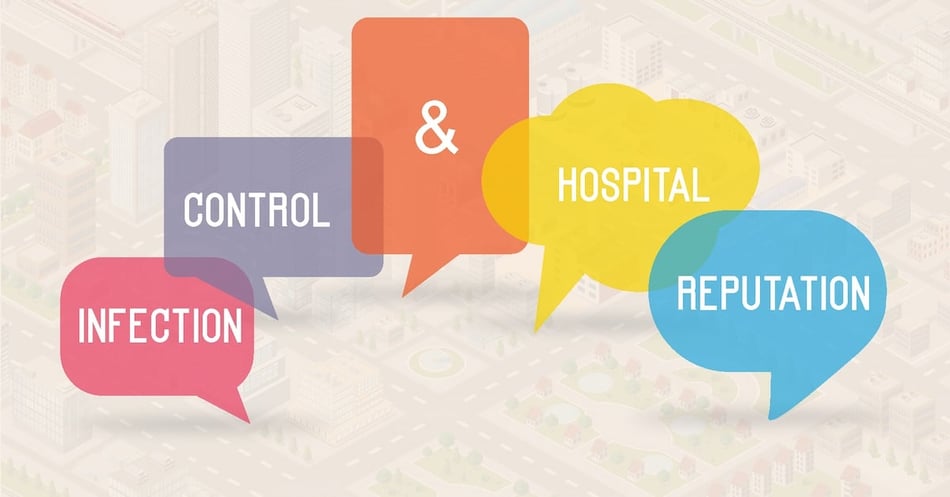Infection Control and Hospital Reputation

The word “reputation” comes from words meaning “to judge repeatedly.” This idea of forming an opinion, and reforming it over and over again as time goes on, is the critical aspect of reputation: It is not something that is set in stone, but rather, is reconsidered and reevaluated indefinitely. This is especially true with a hospital’s reputation, which can move positively or negatively in the span of months, reflecting the impact of news coverage, public ratings, or financial status. So what is the role of infection prevention and control in helping form - and maintain - a hospital’s good reputation?
First, let’s consider all the things that affect a hospital’s reputation. There is word of mouth, including what past patients say about the facility as well as what physicians say about the facility to their patients. Social media plays a huge role here, with well over half of Americans using online forums and connections to learn about health care options and outcomes. Then there are online hospital ratings which pull data from a variety of sources in order to generate their rankings. This now includes CMS’s Hospital Compare, which reports outcomes and patient experience data. Finally, there is media coverage and public relations, including news stories, press releases, advertisements, and other public stories about the facility. The end result is a subjective measure of reputation, but one that impacts things like market share, physician recruitment, and patient retention.
So how can the work of infection prevention and control impact reputation?
Negative impacts due to infection prevention and control are sudden, dramatic, and persistent. A facility's good reputation is threatened by an outbreak, a persistent issue with disease transmission, or a significant rate of HAIs - any of which are stories that would be picked up by local and even national news media. Unfortunately, this kind of story picks up speed and can do irreparable damage to a hospital, leading to costly public relations responses. If the hospital is really in distress or disrepair, it may never recover.
Positive impacts on reputation from a successful infection control and prevention program are more difficult to see. The main reason is that you often don't get credit for what doesn't happen. Let’s consider restaurants. You don’t read reviews that say “This restaurant is awesome! I ate three dishes and I didn’t get food poisoning!” and come away with a good impression! Likewise, most patients who don’t get an infection don’t go home raving about how they didn’t get CLABSI, an SSI, or C. diff. (Perhaps if more patients knew that they had a 1:25 chance of getting an HAI, they might shout it from the rooftops.) But many patients may not even be aware of the steps taken to make sure they didn’t get a healthcare associated infection, and what a tremendous amount of work and investment is in place to protect them.
That is, unless you tell them.
It’s difficult to use low HAI rates to enhance a hospital's reputation without doing some focused public relations. While media coverage may pick up a hospital's high ranking on one of the nationally-known consumer ranking sites such as U.S. News and World Report, the vast majority of hospitals are not nearly big enough to ever make it into a newsworthy top 100 or top 10. And yet, the vast majority of hospitals are doing a great job! So unless there is some kind of bad news associated with these community hospitals, they won't be getting much organic media coverage.
The solution is education and consumer communication. Hospital's need to proactively educate their news contacts and physician communities about the steps they are taking to reduce and eliminate infections. They need to show off new programs and new technologies in ads and press releases. They need to educate current patients about the steps that are being taken to protect them through informative signs, nurse communication, and customer relations interactions.
For example, if your hospital just invested in preventive biocidal surfaces to kill bacteria, tell your patients that their overbed table, bedrails, or nightstands are helping keep them safe! Make sure your area referring physicians know that you have this new technology by inviting them to take a tour and learn about it, or send them a link to the journal article that convinced you to invest in it so that they can research the material on their own.
An effective information campaign that educates and doesn't instill fear is a difficult line to walk. But in the case of infection control and hospital reputation, what consumers don't know about how different facilities in their area approach infection control can hurt them. Consumers may have more information than ever at their fingertips, but research shows that less than 5% of Americans use HospitalCompare to help them choose a hospital. So it is our job to make sure they know just how good of a job we are doing at protecting them from preventable infections - so good that we can stake our reputations on it!
Editor's Note: This post was originally published in October 2019 and has been updated for freshness, accuracy and comprehensiveness.
![EOScu Logo - Dark - Outlined [07182023]-01](https://blog.eoscu.com/hubfs/Eoscu_June2024/Images/EOScu%20Logo%20-%20Dark%20-%20Outlined%20%5B07182023%5D-01.svg)

![[infographic] Hospital Ratings Data Sources Download and share!](https://no-cache.hubspot.com/cta/default/216314/interactive-178908753580.png)



